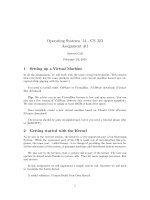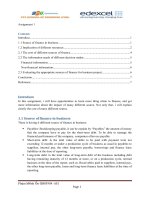1623 assignment 1 (pass)
Bạn đang xem bản rút gọn của tài liệu. Xem và tải ngay bản đầy đủ của tài liệu tại đây (1.12 MB, 31 trang )
Assignment Brief 1 (RQF)
Higher National Certificate/Diploma in Computing
Student Name/ID Number:
Đào Vĩnh Khang
Unit Number and Title:
Unit 5: Security
Academic Year:
2022 – 2023
Unit Assessor:
SamNX
Assignment Title:
Security Presentation
Issue Date:
September 8st, 2022
Submission Date:
Internal Verifier Name:
Date:
Submission Format:
Format:
● The submission is in the form of an individual written report. This should be written in a concise,
formal business style using single spacing and font size 12. You are required to make use of
headings, paragraphs and subsections as appropriate, and all work must be supported with research
and referenced using the Harvard referencing system. Please also provide a bibliography using the
Harvard referencing system.
Submission
● Students are compulsory to submit the assignment in due date and in a way requested by the
Tutor.
● The form of submission will be a soft copy posted on />● Remember to convert the word file into PDF file before the submission on CMS.
Note:
● The individual Assignment must be your own work, and not copied by or from another student.
●
If you use ideas, quotes or data (such as diagrams) from books, journals or other sources, you
must reference your sources, using the Harvard style.
● Make sure that you understand and follow the guidelines to avoid plagiarism. Failure to comply
this requirement will result in a failed assignment.
Unit Learning Outcomes:
1
LO1 Assess risks to IT security.
LO2 Describe IT security solutions.
Assignment Brief and Guidance:
Assignment scenario
You work as a trainee IT Security Specialist for a leading Security consultancy in Vietnam called FPT
Information security FIS.
FIS works with medium sized companies in Vietnam, advising and implementing technical solutions to
potential IT security risks. Most customers have outsourced their security concerns due to lacking the
technical expertise in house. As part of your role, your manager Jonson has asked you to create an
engaging presentation to help train junior staff members on the tools and techniques associated with
identifying and assessing IT security risks together with the organizational policies to protect business
critical data and equipment.
Tasks
In addition to your presentation, you should also provide a detailed report containing a technical review
of the topics covered in the presentation.
Your presentation should:
•
Identify the security threats FIS secure may face if they have a security breach. Give an example
of a recently publicized security breach and discuss its consequences
•
Describe a variety of organizational procedures an organization can set up to reduce the effects to
the business of a security breach.
•
Propose a method that FIS can use to prioritize the management of different types of risk
•
Discuss three benefits to FIS of implementing network monitoring system giving suitable reasons.
•
Investigate network security, identifying issues with firewalls and IDS incorrect configuration and
show through examples how different techniques can be implemented to improve network
security.
•
Investigate a ‘trusted network’ and through an analysis of positive and negative issues determine
how it can be part of a security system used by FIS.
Your detailed report should include a summary of your presentation as well as additional, evaluated or
critically reviewed technical notes on all of the expected topics.
2
Learning Outcomes and Assessment Criteria (Assignment 1):
Learning Outcome
LO1
Pass
P1 Identify types of
security threat to
organisations.
Give an example of a
recently publicized
security breach and
discuss its
consequences.
Merit
M1 Propose a method
to assess and treat IT
security risks.
P2 Describe at least 3
organisational security
procedures.
LO2
P3 Identify the
potential impact to IT
security of incorrect
configuration of
firewall policies and
IDS.
M2 Discuss three
benefits to implement
network monitoring
systems with
supporting reasons.
P4 Show, using an
example for each, how
implementing a DMZ,
static IP and NAT in a
network can improve
Network Security.
3
Distinction
D1 Investigate how a
‘trusted network’ may
be part of an IT
security solution.
Contents
1 IDENTIFY TYPES OF SECURITY THREATS TO ORGANIZATIONS. GIVE AN EXAMPLE OF A
RECENTLY PUBLICIZED SECURITY BREACH AND DISCUSS ITS CONSEQUENCES (P1) .............. 6
1.1
Define threats ............................................................................................................................................. 6
1.2
Identify threats agents to organizations........................................................................................... 6
1.3
List the type of threats that organizations will face ..................................................................... 8
1.3.1
1.3.2
1.3.3
1.4
What are the recent security breaches? List and give examples with dates ..................... 11
1.4.1
1.4.2
1.4.3
1.4.4
2
Human errors and mistakes................................................................................................................................................. 8
Malicious human activity ................................................................................................................................................... 8
Natural Events and Disasters ......................................................................................................................................... 11
Security Breaches Definition: ......................................................................................................................................... 11
Recent Security Breaches, List and give examples with dates ........................................................................ 11
The Consequences of Those Breaches ....................................................................................................................... 14
Suggest solutions to organizations: ............................................................................................................................. 14
DESCRIBE AT LEAST 3 ORGANIZATIONAL SECURITY PROCEDURES ................................. 15
2.1
Definition ................................................................................................................................................... 15
2.2
Discussion on Incidence response policy ....................................................................................... 16
2.3
Discussion on Acceptable Use Policy ............................................................................................... 17
2.4
Discussion on Remote Access Policy ................................................................................................ 18
3 IDENTIFY THE POTENTIAL IMPACT ON THE SECURITY OF INCORRECT
CONFIGURATION OF FIREWALL POLICIES AND IDS ........................................................................ 19
3.1
Firewall Definition .................................................................................................................................. 19
3.2
How Does a Firewall Provide Security to A Network? ............................................................... 21
3.3
IDS Definition ........................................................................................................................................... 22
3.3.1
3.3.2
IDS Usage................................................................................................................................................................................. 23
How Does IDS Work ........................................................................................................................................................... 23
3.4 The Potential Impact (Threat-Risk) Of A Firewall and IDS If They Are Incorrectly
Configured in A Network ................................................................................................................................... 24
4 SHOW, USING AN EXAMPLE FOR EACH, HOW IMPLEMENTING A DMZ, STATIC IP, AND
NAT IN A NETWORK CAN IMPROVE NETWORK SECURITY............................................................ 24
4.1
Definition ................................................................................................................................................... 24
4.2
How Does DMZ Work ............................................................................................................................. 25
4.3
Advantages Of DMZ................................................................................................................................. 26
4.4
Definition ................................................................................................................................................... 27
4.5
Definition ................................................................................................................................................... 28
4.3.1
4.3.2
4.4.1
4.4.2
4.5.1
4.5.2
Service of DMZ: ..................................................................................................................................................................... 26
The Importance of Dmz Networks ............................................................................................................................... 26
How static IP addresses work ........................................................................................................................................ 27
Advantages of Static IP ...................................................................................................................................................... 27
How Does NAT Work ......................................................................................................................................................... 28
Types of NAT ......................................................................................................................................................................... 29
4
4.5.3
NAT security .......................................................................................................................................................................... 29
5
Assignment
INTRODUCTION
Data frequently travels freely between people, organizations, and enterprises in today's datadriven and globally linked society. Data has significant worth, something cybercriminals are
aware of. Hence, the demand for security experts to secure and defend an organization from
assault is increasing due to the continual rise in cybercrime. To help me get deeper knowledge
in this field, this report will discuss some fundamentally basic theories of security including
identifying types of security threats to organizations, organizational security procedures,
Firewall policies, IDS, DMZ, static IP, and NAT in a network.
1
1.1
IDENTIFY TYPES OF SECURITY THREATS TO ORGANIZATIONS.
GIVE AN EXAMPLE OF A RECENTLY PUBLICIZED SECURITY
BREACH AND DISCUSS ITS CONSEQUENCES (P1)
Define threats
Software assaults, loss of intellectual property, identity theft, theft of equipment or
information, sabotage, and information extortion are all examples of information security
threats.
Anything that can exploit a vulnerability to breach security and negatively change, delete, or
injure an item or object of interest is considered a threat. In this tutorial series, we'll define a
threat as a potential hacker attack that allows someone to obtain unauthorized access to a
computer system (Garg, 2021).
Figure 1: threat security
1.2
Identify threats agents to organizations
Nation States: Companies in specific industries, such as telecommunications, oil and gas,
mining, power generation, national infrastructure, and so on, may become targets for other
6
countries, either to disrupt operations today or to provide that nation with a future grip in times
of crisis.
Non-target specific (Ransomware, Worms, Trojans, Logic Bombs, Backdoors, and Viruses
perpetrated by vandals and the public):
•Companies have told me several times, "Oh, we're not going to be a target for hackers
because..." However, because the number of random assaults that occur every day is so large
(there are no reliable numbers to give here), any organization can become a victim.
•The WannaCry ransomware assault, which infected over 200,000 machines in 150 countries,
is the most well-known example of a non-target-specific attack. It caused the NHS in the United
Kingdom to be shut down for many days. Of course, there's the bored teenager in a loft
someplace who's just looking for a weak link on the internet. Employees and Contractors
•Morrisons was penalized because the company did not have the required technological and
organizational procedures in place to prevent the ex-employee from committing the crime
(note that Morrisons is currently appealing the fine).
•There are instances when businesses want specialized assistance and hire contractors or
external organizations who require access to their systems or data. These third parties are
frequently the source of problems since their equipment may not have the same degrees of
security as the controller's data.
Terrorists and Hacktivists
• (political parties, media, enthusiasts, activists, vandals, public, extremists, religious followers)
Similar to the threat posed by nation-states, the amount of harm posed by these agents is
dependent on your activity. However, some terrorists choose to target certain sectors or
nations, so you may face constant fear of a random assault.
•The Wikileaks dumps of diplomatic cables and other documents linked to the combat in Iraq
and Afghanistan in 2010 are perhaps the most prominent example of this. Organized crime
(local, national, transnational, specialist)
•Criminals are after personal information for a variety of purposes, including credit card fraud,
identity theft, and bank account fraud. These crimes are now being carried out on a large basis.
The methods employed vary, from phishing attempts to 'Watering Hole' websites, but the
ultimate effect is the same: your data and you are being harvested and exploited for evil
purposes.
•According to the 2018 Frauds cape report from the Credit Industry Fraud Avoidance Society
(Cifas), the number of identity fraud cases grew in 2017, with about 175,000 cases reported.
Although this is only a 1% rise from 2016, it is a 125 percent increase from a decade earlier,
with 95 percent of these cases including the impersonation of an innocent victim. Natural
disasters (fire, flood, earthquake, volcano)
•Although not a cyber assault, these occurrences can have a similar impact on your capacity to
do business.
•If you can't get into your offices, data centres, or cloud-based information, you're still dealing
with a data disaster, which must be considered. The risk of an earthquake in the United
Kingdom is quite low, but every year we see images of a town or metropolis submerged in
water. Corporates (competitors, partners)
•Although the fear of a rival stealing your intellectual property is evident, we are increasingly
collaborating with a wide range of partners to address skills and resource gaps, as well as to
supply services. Depending on their motivations, these partner firms may steal or expose your
intellectual property or personal data, either unintentionally or deliberately.
7
•The attack on the US retailer Target in 2013 is perhaps the best example of how partner
organizations may be the source of a breach. The hackers targeted (pardon the pun!!) suppliers
and discovered a weak link with Fazio Mechanical, an HVAC contractor. The hackers gained
access to Target's point-of-sale systems by sending a phishing email to a Fazio employee. This
allowed them access to up to 40 million credit and debit cards from customers who visited its
stores throughout the holiday season of 2013. Target has spent more than $200 million on this.
1.3 List the type of threats that organizations will face
There are three main sources of threats:
1.3.1 Human errors and mistakes
Accidental problems
Poorly written programs
Poorly designed procedures
Physical accidents
User destructing systems, applications, and data
User violating security policy
Disgruntled employees waging war on the company or causing sabotage
Employee extortion or blackmail.
1.3.2 Malicious human activity
APT (Advanced Persistent Threats)
When it comes to hacking a business, cybercriminals who use Advanced Persistent Threats
(APTs) aim to play the long game. They penetrate a computer network invisibly and in close
synchronization, looking for access and departure points that will allow them to remain
unnoticed.
Figure 2: Criminal network
They snoop about, install specialized harmful programs, and acquire essential data and
sensitive information once inside an organization (RSI, 2021).
Here are commonly five progressions that an Advanced Persistent Threat undergoes to
strengthen its damage:
8
•
•
•
•
•
Infiltration of Access: Phishing, trojan horses, and malware are used by APT attackers to
gain access to the system.
Grip Strengthening: The ability of an Advanced Persistent Threat to gain a foothold
inside a company is its strength.
Invasion of the System: APT attackers will begin attacking the system by getting
administrator access and breaking passwords left and right once they have complete
freedom of movement.
Lateral Movement: hackers have made the enterprise their playground.
Deep Machinations: The APT attackers have total control of the company during this
phase, deleting all evidence of their intrusion and building a solid backdoor for future
use.
They employ cutting-edge technologies such as malware and computer intrusion tactics to
compromise an organization's cybersecurity. These cybercriminals are ruthless, preferring to
utilize stealthy methods to obtain access to an organization and inflict havoc (RSI, 2021).
Distributed Denial of Service (DDoS)
When fraudsters use Distributed Denial of Service or DDOS, their primary purpose is to
disrupt a website.
In a nutshell, they swarm a target network with fake requests to overburden the system and
cause it to fail. Because the website will be offline, legitimate users or clients will be unable to
access it. Because of these unneeded interruptions, DDoS can result in significant production
losses.
Figure 3: Hack networking
Because the incoming onslaught does not come from a single source, it is impossible to
counter a Distributed Denial-of-Service assault. Consider a restaurant where a rowdy throng
gathers at the front door to create a ruckus.
Ransomware
Once hackers have established a foothold in your network, ransomware is a type of virus from
crypto virology that hackers execute and encrypt to perfection. They take crucial business data
9
or sensitive personal information from clients, then threaten to jeopardize the material unless
the target organization pays a ransom.
Over time, ransomware has evolved into a popular way of extorting money from businesses.
The important information found within an infiltrated network is weaponized by digital
attackers. To lure employees into the firm, standard ways include presenting an innocent
attachment or link.
Phishing
Phishing is one of the most common ways for hackers to get access to a system. Other
sophisticated security concerns, such as ransomware and Distributed Denial of Service (DDoS),
can be accessed through it (DDoS).
Phishing is mostly based on deception. Attackers create email blasts that look to come from
a reputable source. Clicking on these attachments or URLs without realizing it can infect a
machine and its network.
Hackers posing as a senior employee, or a client organization are common impersonations.
They may pose as a business transaction or a bank request, which the victim employee would
expect. Phishing's success is determined by how sophisticated it is and how well it can track its
targets into communicating realistically.
Worms
Worms are malware that multiplies itself, especially once it has contacted a computer
network.
They seek out weaknesses in a network to expand and extend their presence and effect.
Botnet
A botnet is a combination of the word’s "robot" and "network." It is a collective term for
private computers suffering infestations from malware, making them vulnerable to remote
access by cybercriminals without the organization’s knowledge.
The transmission of spam, the execution of DDoS barrages, and data theft all need this level
of delicate control and understanding of target networks. Botnets are hackers' force multipliers
for disrupting target firms' complicated systems.
Botnet architecture has progressed significantly in terms of evading detection. Its
applications impersonate clients to connect with existing servers. Cybercriminals can then
control these botnets remotely via peer-to-peer networks.
Crypto jacking
Nowadays, cryptocurrency is all the trends. It requires the tactic of mining to generate more
currency organically. Phishing tactics have been used by cybercriminals to infect and hijack
more slave machines that will be used to mine cryptocurrencies.
Because targets are unaware that their resources are being used to mine cryptocurrency,
crypto jacking can cause slower computers.
10
1.3.3 Natural Events and Disasters
Fires, floods, hurricanes, earthquakes, tsunamis, avalanches, and other acts of nature. This
type of threat includes losses resulting from activities taken to recover from the first problem,
as well as losses resulting from actions taken to recover from the initial problem. Document
shared on www.docsity.com
1.4 What are the recent security breaches? List and give examples with dates
1.4.1 Security Breaches Definition:
A successful effort by an attacker to obtain unauthorized access to an organization's
computer systems is referred to as a security breach. Theft of sensitive data, corruption or
sabotage of data or IT systems, or acts meant to deface websites or harm reputation are all
examples of breaches (Cassetto, 2019).
1.4.2 Recent Security Breaches, List and give examples with dates
1.4.2.1 Sina Weibo (March 2020)
Sina Weibo is one of China's most popular social media networks, with over 600 million
members. The firm started in March 2020 that an attacker had gained access to a portion of its
database, affecting 538 million Weibo users and their personal information, including actual
names, site usernames, gender, location, and phone numbers. The database was reportedly sold
on the dark web for $250 by the attacker.
Weibo has been asked by China's Ministry of Industry and Information Technology (MIIT) to
improve
It's data security procedures to better secure personal data and to alert users and authorities
when data
security breaches occur. Sina Weibo said in a statement that an attacker obtained publicly
available information by utilizing a tool designed to assist users to find their friends' Weibo
accounts by providing their phone numbers, but that no passwords were compromised.
However, it recognized that if passwords are repeated on other accounts, the leaked data might
be used to link accounts to passwords. The corporation stated that it had enhanced its security
11
policy and had informed the proper authorities of the situation (Michael Hill and Dan Swinhoe,
2021).
1.4.2.2 Nintendo (April 2020)
Nintendo stated in April 2020 that 160,000 accounts had been compromised in a suspected
credential stuffing attack. Hackers were able to get access to user accounts using previously
disclosed user IDs and passwords, allowing them to purchase digital things using stored cards
and read private data such as name, email address, date of birth, gender, and nationality.
The gaming behemoth has been investigating the incident and has subsequently disclosed that
they believe an additional 140,000 accounts were stolen, increasing the total number of
infected accounts to 300,000. All impacted customers' passwords have been changed, and users
are advised not to use the same password for numerous accounts and services.
1.4.2.3 Zoom (April 2020)
When staff was settling into their new working from home environment at the beginning of
April, it was revealed that virtual conference tool Zoom had suffered a humiliating security
breach, exposing the login data of over 500,000 users.
Hackers appear to have gotten access to the accounts by exploiting username and password
combinations stolen in prior data breaches in yet another credential stuffing assault. The
information was subsequently sold for as low as 1p on dark web hacker forums.
Login credentials, email addresses, personal meeting URLs, and Host Keys were among the
information stolen. Criminals were able to log in and attend meetings or use the information
for other nefarious reasons, because of this.
1.4.2.4 LinkedIn (June 2021)
In June 2021, data linked with 700 million LinkedIn members were released on a dark website,
affecting more than 90% of the company's user base. Data scraping techniques were utilized by
a hacker known as "God User," who exploited the site's (and others) API before releasing the
first data collection of about 500 million consumers. They then boasted that they were selling
the whole 700-million-person consumer database.
1.4.2.5 Data on 3.3 million Audi Customers Exposed in Unsecured Database (June
2021)
Volkswagen said in June 2021 that 3.3 million Audi customers' data, including present and
potential purchases, had been left publicly available online. Names, email addresses, and phone
numbers, as well as vehicle-related data, were included in the data cache, which was obtained
between 2014 and 2019.
Around 90,000 people were impacted, and additional sensitive information was taken. This
may contain Social Security numbers and dates of birth.
The data was exposed online at some point between August 2019 and May 2021, according to
the business. The organization continues to investigate the occurrence in order to establish a
precise timeframe.
12
1.4.2.6 Kaseya Ransomware Attack (July 2021)
Kaseya, a supplier of IT solutions, had a significant attack on their unified remote monitoring
and network perimeter protection product in July 2021. A supply chain ransomware assault
targeted managed service providers and their downstream clients, stealing administrative
control of Kaseya services.
The assault, according to ZDNet, disrupted Kaseya's SaaS servers and impacted on-premises
VSA solutions used by Kaseya clients in 10 countries. Kaseya was quick to respond to the
incident by notifying
Its customers. The Kaseya VSA detection tool was released by the corporation, allowing
business users to assess their VSA services and manage endpoints for symptoms of
vulnerabilities.
1.4.2.7 Databases and Account Details on Thousands of Microsoft Azure
Customers Exposed (August 2021)
Due to a Cosmos DB vulnerability, Wiz security experts were able to acquire access to Microsoft
Azure account credentials and client databases in August 2021. The weaknesses resulted in a
loophole, allowing people to access databases that were not their own. The problem impacted
a wide spectrum of businesses, including numerous Fortune 500 enterprises.
It's unclear whether anyone other than the security experts had access to the data. Anyone who
did get access to the systems, on the other hand, would have had unrestricted ability to
download, delete, and modify records.
1.4.2.8 Crypto.com (January 2022)
According to security firm Peck shield, CryptoCrypto.com was hacked for 4,600 ETH valued at
roughly $15 million. Users began reporting strange behaviour with their accounts yesterday,
and Crypto.com responded quickly to stop withdrawals, but not before the hackers snatched
the Ethereum loot. Crypto.com claims that no user funds were stolen, implying that the breach
occurred on the company's hot wallets, though this does not explain why users were the first
to notice unusual activity in their accounts.
After a few hours, Crypto.com confirmed that certain customers had suffered "unauthorized
activity" in their accounts, but added that "all monies are secure," which doesn't explain why
some users' accounts had lost ETH.
1.4.2.9 Microsoft Breached by Lapsus$ Hacker Group (March 2022)
The hacker group Lapsus$ shared a screenshot to their Telegram channel on March 20, 2022,
claiming
that they had hacked Microsoft. The screenshot was obtained in Azure DevOps, a Microsoft
collaboration tool, and it revealed that Bing, Cortana, and other Microsoft projects had been
hacked.
Microsoft published a statement on March 22 acknowledging that the assaults had taken place.
According to Microsoft, only a single account was hijacked, and the company's security staff
was able to terminate the assault before Lapsus$ could enter any further into their business.
13
1.4.3 The Consequences of Those Breaches
Sina Weibo: affecting 538 million Weibo users and their personal information, including actual
names, site usernames, gender, location, and phone numbers.
Nintendo: 160,000 accounts had been compromised in a suspected credential stuffing attack,
approximately 300,000 accounts had been affected.
•
•
•
•
•
•
•
Zoom: It was revealed that virtual conference tool Zoom had suffered a humiliating
security breach, exposing the login data of over 500,000 users. The information was sold
on dark web forums.
LinkedIn: 700-million-person consumer database was sold and released for free on the
dark web.
Audi Database: 3.3 million Audi customers' data, including present and potential
purchases, had been left publicly available online. Around 90,000 people were impacted,
and additional sensitive information was taken
Kaseya: A supply chain ransomware assault targeted managed service providers and
their downstream clients, stealing administrative control of Kaseya services.
Microsoft Azure: The problem impacted a wide spectrum of businesses, including
numerous Fortune 500 enterprises.
Crypto.com: 4,600 ETH valued at roughly $15 million was hacked and moved to
ambiguous wallets.
Microsoft: Bing, Cortana, and other Microsoft projects had been hacked.
1.4.4 Suggest solutions to organizations:
Quickly deploy a highly qualified and experienced cyber security team and our cutting-edge
technologies to your organization, whether you've had a breach or want to build an effective
response capacity. Work to develop visibility, address concerns, and implement strategies to
prevent repeat accidents.
Define, detect, defend, and prevent, for successful breach management, there are four
essential criteria solutions. Define To identify and defend against threats, businesses must
create an entire strategy and security lifecycle. Planning, risk assessment, policy formulation,
and controls should all be addressed. A strong business and technical architecture may
significantly increase the amount of resilience needed to survive a coordinated attack (Zola,
2019).
•Define: To identify and defend against threats, businesses must create an entire strategy and
security lifecycle. Planning, risk assessment, policy formulation, and controls should all be
addressed. A strong business and technical architecture may significantly increase the amount
of resilience needed to survive a coordinated attack. By incorporating security into this
architecture, businesses can rest certain that they are as secure as possible in the event of a
compromise.
•Detect: An attack's harm is limited if it is detected early. An organization needs to have the
capacity to monitor and detect prospective activity when it has a clear and defined plan.
Knowing the sorts of assaults, attack sites, and attack vectors employed requires an
understanding of baseline environment volumes, types, and performance. To build a system for
14
acquiring situational awareness and actionable security intelligence that can help you prepare
for speedy alerting of assaults, you'll need a combination of people, processes, and technology.
•Defend: There are no fail-safe techniques available to avoid attacks; nonetheless, it’s suggested
that defining plans to secure the organization’s key services and information. The threat should
be removed, the vulnerability should be closed, and the effect should be controlled as part of
your defensive plan. A strong strategy is a multi-layered defines that enables you to detect a
breach sooner, respond faster, lessen the effect of the breach, and decrease continuing
exposure. Therefore, costs are reduced, control is increased, and risk exposure is reduced over
time.
•Deter: Organizations can identify and defeat a variety of attack tactics and sources by
collaborating and sharing security intelligence. There is support for legal action against
attackers since there are effective processes in place for recording, reporting, and auditing
security breaches.
2
DESCRIBE AT LEAST 3 ORGANIZATIONAL SECURITY
PROCEDURES
2.1 Definition
A security process is a collection of steps that must be followed to complete a certain security
duty or function. Procedures are often developed as a set of actions to be performed in a
consistent and repeatable manner to achieve a certain goal. Security procedures, once
developed, give a set of defined steps for performing the organization's security affairs, making
training, process auditing, and process improvement easier. Procedures serve as a starting
point for establishing the uniformity required to reduce variance in security procedures, hence
improving security control inside the business. In the security sector, reducing variance is also
an excellent method to reduce waste, enhance quality, and boost performance (Patterson,
2018).
15
2.2 Discussion on Incidence response policy
Incident Response (IR) Procedure: Provide the necessary procedures for incident management,
reporting, and monitoring, as well as incident response training, testing, and support, to ensure
that the is
prepared to respond to cyber security incidents, secure State systems, and data, and avoid
interruption of government services.
This type of policy usually includes information about:
•
•
•
•
•
the organization's incident response team.
Each team member's role.
The people in charge of testing the policy.
How to put the policy into action.
The technological means, tools, and resources that will be used to identify and recover
compromised data.
Incidents Phases:
Preparation phase: The way users of a system and the IT professionals in charge of it are
taught and prepared to respond to security issues is known as the preparation phase. This
phase should involve not only the identification of tools and resources that might be used
during an incident but also the implementation of preventative actions like conducting periodic
risk assessments and raising user awareness.
Identification phase: Identifying and detecting a security incident, as well as establishing the
severity and priority level of the discovered problem. This phase entails (i) identifying incidents
that use common attack vectors (e.g., attacks via removable media, the Web, and e-mail); (ii)
recognizing signs of incidents; (iii) identifying detectable precursors; (iv) performing initial
analysis and validation through file integrity checking; (v) running packet sniffers; (vi) filtering
data, and (vii) evidence preservation.
Containment phase: Instructions on how to separate systems that have been impacted by the
assault to avoid further damage to other systems.
Eradication phase: Determining the cause of the occurrence and removing the impacted
systems. Recovery phase: Returning afflicted systems to their regular operating environment.
Post-incident phase: recording the whole occurrence, performing a comprehensive
investigation, determining the reason for the incident, assessing related expenses, and
formulating a strategy to prevent future events.
Elements of an incident response policy:
Identification of an incident response team o There are two types of incident response teams:
centralized incident response teams and dispersed incident response teams. Small
organizations are more likely to adopt the first type, but large organizations are more likely to
use the second because it allows them to successfully coordinate people in culturally,
linguistically, and legally varied situations.
o Occurrence response teams can be made up entirely of company workers or outsourced
largely or completely, depending on the sort of incident. Furthermore, the company must verify
16
that the members are not only specified in the agreement but also appropriately taught to carry
out their tasks and obligations.
Information about the system: System specifics, such as network and data flow diagrams,
hardware inventories, and logging data, should be included in the policy.
Incident handling and reporting procedures: Another important section of the policy should
define the methods for dealing with and reporting an event (suspected or occurred). Such
processes should identify what occurrences will trigger response measures, in addition to
guidance on how to report the incident (e.g., the timing of the incident, a list of corrupted or
inaccessible data, and mitigation techniques in place). For example, the rules should address
whether the organization would respond to a prospective attack or if the assault must be
successful to trigger response measures.
“Lessons Learned”: The "Lessons Learned" part of an incident response policy is an essential
feature that is sometimes overlooked. Such a "Lessons Learned" effort, which uses a meeting
and a discussion among all stakeholders concerned, might be a useful tool in enhancing security
measures in the business and the incident handling process itself.
Reporting to outside parties: Timeframes and procedures for reporting to third parties, such
as IT workers, security analysts, data protection or law enforcement agencies, media, impacted
external parties, and software providers, may be included in an incident response policy.
Incident reporting may be mandated by law in some jurisdictions.
2.3 Discussion on Acceptable Use Policy
Acceptable Use Policy (AUP): An AUP outlines the restrictions and procedures that employees
who use organizational IT assets must accept to have access to the business network or the
internet. For new employees, it is a typical onboarding protocol. Before being assigned a
network ID, they must read and sign an AUP. It is suggested that the IT, security, legal, and HR
departments of a firm consider what is included in this policy (Anon., 2008).
General Use and Ownership:
This policy applies to any data produced or stored on the Organization's systems.
All data including non-public personal information must be encrypted before being
electronically transmitted.
Non-public personal information and other sensitive information shall be encrypted
following the Information Sensitivity Procedures in all other circumstances.
For this policy, all information and data residing on the organization's systems and networks
are considered the organization's property.
For any reason, at any time, with or without notice, the organization may monitor or audit
any information, including data files, emails, and information stored on company-issued
computers or other electronic devices, for testing and monitoring compliance with these
security procedures.
Without sufficient authority, all sensitive material must be kept secret and not distributed or
made available to anybody. Sensitive data will be utilized purely and exclusively for the
17
investigation. It is only to be used for the administration of receivership and not for any other
purpose.
Security and Proprietary Information:
The official website of the organization should not include any sensitive information.
Information on the organization's systems, including public and private websites, should be
categorized as either public or sensitive, according to the organization's information sensitivity
policies.
Passwords must be kept confidential and not shared with anyone else. The security of their
passwords and accounts is the responsibility of authorized users.
•
•
•
•
•
Passwords at the user level must be updated by the organization's systems usage
policy but at the very least every six months. Accounts at the user level include but are
not limited to: Email
Web
Social
Media
Access to sensitive information through application accounts
Authorized users must exercise great caution when opening e-mail attachments, which may
include viruses, e-mail bombs, or Trojan horse code, either purposefully or inadvertently. All
users must be taught how to recognize possible threats (Anon., 2008).
2.4 Discussion on Remote Access Policy
Remote Access Policy:
The remote access policy is a document that discusses and specifies permissible means of
connecting to an organization's internal networks from a remote location. I've also seen
addendums to this policy including rules for using BYOD assets. This policy is required for
enterprises with scattered networks that might extend into unsecured network locations, such
as the neighbourhood coffee shop or unmanaged home networks.
General:
All employees, contractors, suppliers, and other people who have access to the Organization
network must agree to keep all access procedures and codes confidential and not disclose them
to
anyone else. Employees, contractors, suppliers, and agents have access privileges to
Organization's network must guarantee that their access connections are subject to security
measures that are essentially comparable to Organization.
Requirements:
Secure remote access must be rigorously regulated, and only those personnel approved by the
Information Security Officer should have access. One-time password authentication or
public/private keys with strong passwords must be used to establish authorized access.
Authorized users must not give their login credentials to anyone else, and they must not write
or keep a record of their login credentials (Anon., 2008).
18
Unless the Information Security Officer approves differently, authorized users may only access
the network using equipment provided by Organization.
Authorized users must guarantee that remote connections comply with minimal authentication
standards like CHAP or DLCI.
Authorized users are responsible for ensuring that any remote host connected to the
organization's internal networks is running antivirus software with the most recent virus
definitions.
3
IDENTIFY THE POTENTIAL IMPACT ON THE SECURITY OF
INCORRECT CONFIGURATION OF FIREWALL POLICIES AND IDS
3.1 Firewall Definition
A firewall is a network security device that monitors and filters incoming and outgoing network
traffic according to security regulations set by an organization. A firewall, at its most basic level,
is the barrier that separates a private internal network from the public Internet. The primary
goal of a firewall is to allow non-threatening traffic in while keeping harmful traffic out.
Packet filtering: A tiny quantity of data is examined and delivered by the filter's requirements.
Proxy service: At the application layer, a network security system protects while filtering
communications.
Stateful inspection: Dynamic packet filtering keeps track of current connections to decide
which network packets to let through the Firewall.
Next-Generation Firewall (NGFW): Deep packet inspection Firewall with the applicationlevel inspection.
19
Firewall Policies:
Firewalls are available as both software and hardware appliances. Many hardware-based
firewalls also provide additional services to the internal network they protect, such as
operating as a DHCP server. To guard against attacks from the public Internet, several personal
computer operating systems feature software-based firewalls.
Many routers that transmit data across networks include firewall components, and many
firewalls may perform basic routine duties as well.
Firewall Usage:
Prevents the Passage of Unwanted Content
On the internet, there is no such thing as poor or undesirable content. Unless a robust firewall
is in place, such undesirable content can readily get into the system. Most operating systems
will have a firewall that will successfully protect users from unwanted and harmful internet
information (Pedamkar, 2020).
Prevents Unauthorized Remote Access
There are several unethical hackers in the world today that are always attempting to get access
to weak systems. The uninformed user has no idea who has access to his machine.
A powerful firewall is required to safeguard your data, transactions, and other sensitive
information; for businesses, private data, and information leakage can result in significant loss
and failure.
Prevents Indecent Content
The vast network of the internet has exposed individuals, particularly adolescents and
youngsters, to immoral information. This content's malicious nexus has been rapidly growing.
Exposure to obscene information of any kind can be damaging to young minds, leading to
unusual behaviours and immoral behaviour.
Guarantees Security Based on Protocol and IP Address
Hardware firewalls are effective for inspecting traffic patterns based on a certain protocol.
When a connection is created, a record of activity is retained from start to finish, which helps
to keep the system secure.
Network Address Translation (NAT) is a form of firewall that efficiently protects computers
against attacks from outside their network. Therefore, the IP address of these computers is only
accessible within their network, keeping them independent and protected (Pedamkar, 2020).
Protects Seamless Operations in Enterprises
Enterprise software and systems have grown increasingly important in today's business world.
Authorized stakeholders can utilize and work on the data for effective company operations
thanks to decentralized distribution mechanisms and data access throughout the whole
geographical presence.
A user can log in to his system using credentials from any system on the network. Given such a
large network system and large amounts of data.
Protects Conversations and Coordination Contents
20
Organizations in the service industry must continually communicate with third-party clients.
They continuously share relevant material with the customer and internal teams as part of
various initiatives.
Almost all the content generated by these coordinating operations is secret and must be well
safeguarded; no organization can afford the expense of such essential information being leaked.
Users may watch movies on a variety of websites, and some even enable them to download
games or videos. Similarly, a slew of websites allows you to play and download games. Except
for a few well-known sites, hardly all websites guarantee access security. And there's frequently
a constant stream of harmful stuff in the shape of malware and viruses attempting to infiltrate
the user's machine. A firewall is required in the system because it protects the user's machine
against virus assaults via online games or films.
Advantages of Firewall:
•
•
•
•
•
•
•
•
•
Hackers and remote access are prevented by a firewall.
It safeguards information.
Enhanced security and network monitoring capabilities
It gives you more privacy and security.
Assist the VOIP phone's dependability.
It guards against trojans (Bradley, 2021).
Allow for more advanced network capabilities to be implemented.
An OS-based firewall can only protect single PCs, but a network-based firewall, such as
a router, can protect
many systems.
3.2 How Does a Firewall Provide Security to A Network?
•
•
•
•
Within a private network, firewalls filter network traffic. It determines which types of
traffic should be permitted or prohibited based on a set of regulations. Consider the
firewall as a gatekeeper at the computer's entrance point, allowing only trustworthy
sources, or IP addresses, to gain access to the network.
Only the incoming traffic that has been set to accept is accepted by a firewall. It detects
legitimate and malicious traffic and permits or disallows data packets based on predefined security criteria.
These criteria are based on numerous factors of the packet data, such as the source,
destination, and content, among other things. To avoid cyberattacks, they restrict traffic
from suspected sources.
The graphic below, for example, depicts how a firewall permits excellent traffic to flow
through to a user's private network.
21
Figure 4: Firewall
•
•
•
The firewall in the example below, on the other hand, prevents harmful traffic from
accessing the private network, safeguarding the user's network from a cyberattack
(Bradley, 2021).
A firewall can do fast evaluations to detect malware and other suspicious activity in this
manner.
At different network levels, several types of firewalls are used to read data packets.
Figure 5: Firewall Security
3.3 IDS Definition
An intrusion detection system (IDS) is a network traffic monitoring system that detects
suspicious behaviour and sends out notifications when it is found (Lutkevich, 2021).
While the basic duties of an IDS are anomaly detection and reporting, certain intrusion
detection systems may also act when malicious behaviour or abnormal traffic is discovered,
such as blocking traffic received from questionable IP addresses.
22
An intrusion detection system (IDS) differs from an intrusion prevention system (IPS),
which, like an IDS, analyses network packets for potentially harmful network activity, but
focuses on preventing attacks rather than detecting and documenting them.
3.3.1 IDS Usage
Other security controls intended at detecting, stop, or recover from assaults; monitoring
the functionality of routers, firewalls, key management servers, and files that are required
by other security controls.
Allowing administrators to tweak, manage, and comprehend relevant OS audit trails and
other logs that might otherwise be impossible to follow or interpret.
Including a large attack signature database against which information from the system
may be compared; offering a user-friendly interface so that non-expert staff members can
help with system security management.
When the IDS detects that data files have been changed, it generates an alarm and notifies
the user that security has been broken; attackers are blocked, or the server is blocked.
3.3.2 How Does IDS Work
Intrusion detection systems are used to identify irregularities in the network to capture
hackers before they do serious damage. Network-based IDSes and host-based IDSes are
both possible. The client computer has a host-based intrusion detection system, whereas
the network has a network-based intrusion detection system.
Figure 6: How IDS Work
Intrusion detection systems detect assaults by looking for signs of previous attacks or
deviations from regular behaviour. These abnormalities are moved up the stack and
investigated at the protocol and application layers. They can detect occurrences such as
Christmas tree scans and DNS poisonings.
An IDS can be deployed as a client-side software program or as a network security device. To
safeguard data and systems in cloud deployments, cloud-based intrusion detection solutions
are now available (Luckovich, 2021).
23
3.4
The Potential Impact (Threat-Risk) Of A Firewall and IDS If They Are
Incorrectly Configured in A Network
Unencrypted HTTP connections can be abused by an outsider on the same network segment,
such as an open/unencrypted wireless network, allowing anybody on the Internet to access the
firewall. On the external interface, anti-spoofing restrictions are not enabled, which can permit
denial of service and associated attacks. Without logging, rules exist, which may be troublesome
for key systems and services.
Internal network segments can be connected by any protocol/service, which can lead to
internal breaches and compliance violations, especially in PCI DSS cardholder data settings.
Unencrypted telnet connections allow anyone on the internal network to connect to the
firewall. If ARP poisoning is enabled by a tool like the free password recovery application Cain
& Abel, these connections can be abused by an inside user (or malware).
Any sort of TCP or UDP service can leave the network, allowing malware and spam to
proliferate and resulting in permissible use and policy breaches.
There is no documentation for the rules, which might lead to security management concerns,
especially when firewall administrators leave the company unexpectedly.
The default password(s) are used, resulting in every security risk imaginable, including
responsibility concerns when network events occur.
Firewall OS software is ancient and no longer supported, making it vulnerable to known
weaknesses such as remote code execution and denial of service attacks. It also may not look
good in the eyes of third parties if a breach happens and the system's age is revealed.
Anyone on the Internet may access internal Microsoft SQL Server databases, which can lead
to internal database access, especially if SQL Server is configured using the default credentials
(sa/password) or an otherwise weak password.
4
SHOW, USING AN EXAMPLE FOR EACH, HOW IMPLEMENTING A
DMZ, STATIC IP, AND NAT IN A NETWORK CAN IMPROVE
NETWORK SECURITY
4.1 Definition
A DMZ Network is a perimeter network that protects and adds an extra layer of security to an
organization’s internal local-area network from untrusted traffic. A common DMZ is a
subnetwork that sits between the public internet and private networks (Ohri, 2021).
24
The purpose of a DMZ is to allow an organization to connect to untrusted networks, such as the
internet while maintaining the security of its private network or LAN. External-facing services
and resources, as well as servers for the Domain Name System (DNS), File Transfer Protocol
(FTP), mail, proxy, Voice over Internet Protocol (VoIP), and web servers, are often stored in the
DMZ.
4.2
How Does DMZ Work
Any gadget that is connected to the internet bears the brunt of most attacks and hence bears
the most danger. Companies that have public servers that must be accessible by persons
outside the company are more vulnerable to assaults. DMZs serve as a barrier between an
external and an internal network. When a DMZ is created between two firewalls, all incoming
traffic is filtered by a firewall or security appliance before reaching the organization's server.
Figure 7: How does DWZ work
If a trained bad guy breaks through the company's firewall and obtains unauthorized access to
those systems before they can perform any harmful activity or access the company's sensitive
data, those systems will alert the host that a breach has occurred (Ohri, 2021).
25









